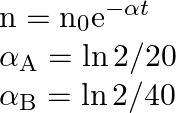Correct answer is B.

After 80 min, remaining number of nuclei for ![]()
After 80 min, remaining number of nuclei for ![]()
Decayed number of nuclei for A, ![]()
Decayed number of nuclei for ![]()
Ratio of decayed number of nuclei is

Correct answer is B.

After 80 min, remaining number of nuclei for ![]()
After 80 min, remaining number of nuclei for ![]()
Decayed number of nuclei for A, ![]()
Decayed number of nuclei for ![]()
Ratio of decayed number of nuclei is
